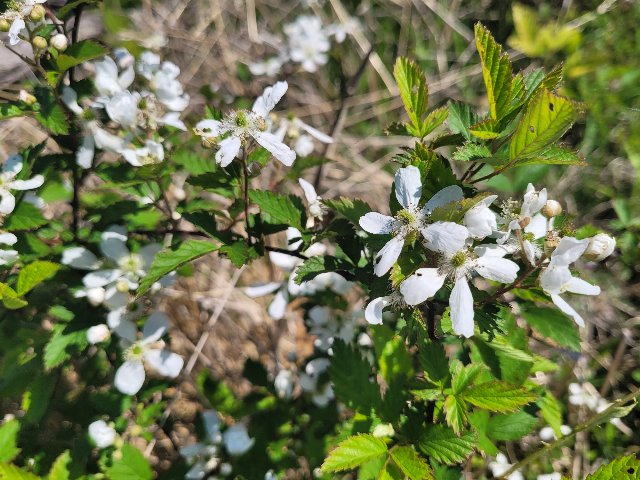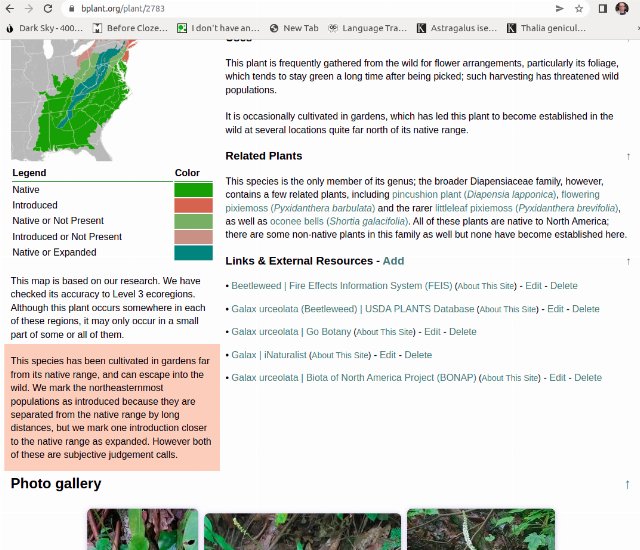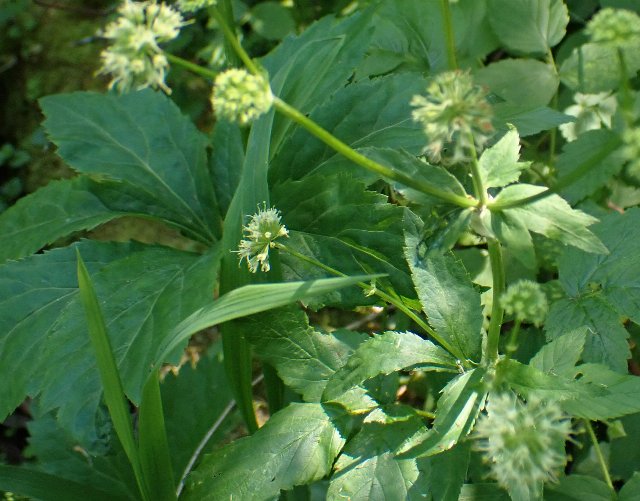More Range Map Improvements, POWO Interlinking, And Notes Fields
June 7th, 2022 by Alex Zorach
This Februrary we announced a major improvement in our plant range maps.Since that update, we have continued to build more maps, and additionally we have refined, expanded, and verified a larger portion of the maps.
As of today, a total of 3,272 maps have been verified to be complete for the entirety of North America. This mostly includes species that occur only in the lower 48 US states, but it includes some species where we have actually built the portion of its range map in Canada, and a few in Mexico.
We have also cleaned up our database, deleting and merging duplicate records, and have reduced the number of plants listed to 20,580.
POWO Interlinking
We have begun the major project of interlinking our site with Plants of the World Online (POWO). POWO is run by the Royal Botanical Gardens in Kew, London, and is primarily a database of plant names using a taxonomic backbone, the International Plant Name Index (IPNI), that is the most up-to-date and comprehensive that we have been able to find. In some cases, POWO also has information on plant distribution and native vs. introduced status in various regions.The process of interlinking our site with POWO is slow and complex, because in many cases, the taxa they recognize and the names they use to refer to them do not correspond in a one-to-one way to the taxa recognized by USDA, BONAP, and other sources. These discrepancies mostly reflect POWO being more up-to-date on the latest taxonomic reclassifications, and they also reflect the correction of errors and inconsistencies in the citing of names, some of which have propagated for hundreds of years.
We have currently linked up 3,032 records on our site with POWO, which represents about 14.7% or a little more than 1/7th of the records. Our goal is to interlink all records.
Why does plant taxonomy matter?
Taxonomy is the branch of science concerned with classifying and naming living organisms. Plant taxonomy is a messy subject, with plants frequently being reclassified and renamed, species split or merged, moved into different genera, or reclassified between proper species and varieties or suspecies. Although at times, plant taxonomy can seem like splitting hairs, it has real-world implications for conservation and ecological restoration work. Blackberries (Rubus subgenus of the Rubus genus) are a group that have experienced frequent reclassifications. Photo © lapemis, Public Domain, Source.
Blackberries (Rubus subgenus of the Rubus genus) are a group that have experienced frequent reclassifications. Photo © lapemis, Public Domain, Source.The biological species concept centers around whether or not organisms from different groups can interbreed and produce fertile offspring. Although there are many complexities and nuances, the basic idea is that plants of the same species can freely interbreed, whereas ones belonging to separate species either cannot produce fertile offspring at all, or can only do so rarely or with difficulty.
More up-to-date knowledge about which populations of plants constitute separate species and which do not is important both for conservation of native plant species, and monitoring of introduced species that may have risk of becoming invasive. Interbreeding can introduce new genetic material into small, isolated local populations of plants, giving them greater ability to adapt to threats and changing conditions. Similarly, interbreeding can increase the risk that introduced species will develop greater vigor and become invasive. And whether or not a local, morphologically-distinct population represents its own, possibly endangered species with unique genetics, vs. a quirky manifestation of an abundant species that is not threatened, can also help conservationists prioritize which populations to protect.
We hope that by keeping our taxonomic backbone more up-to-date we can ultimately help inform conservation and ecological restoration work, both with respect to protecting native species and keeping an eye on introduced species that have established in the wild and may pose a risk of becoming invasive at some point in the future.
New Notes Fields
Our plant articles have always had a "Notes" section, which is somewhat of a "catch-all" category for information that doesn't fit into any of the other sections. Recently, we created two new places on an article where such supplemental comments could be found: range map notes and taxonomy (classification) notes. This screenshot shows the location of the new range map notes (highlighted pink), as viewed on a desktop browser. In an actual article, the notes are not highlighted.
This screenshot shows the location of the new range map notes (highlighted pink), as viewed on a desktop browser. In an actual article, the notes are not highlighted.Range Map Notes
Although we have made the best effort to make our range maps self-explanatory, they communicate a lot and there are many cases where there is additional information relevant to a plant's range, distribution, and status (i.e. native, introduced, expanded, etc.) in particular regions, that cannot be fully or easily communicated in a map.In these cases, we have added verbal comments under the map. Some of the reasons you may find comments include:
- When there is a major discrepancy in ranges reported by different sources, such as USDA, BONAP, POWO, or various regional flora or plant atlases. In these cases we often explain the discrepancy and note which source(s) we have favored in our map.
- When we needed to make a difficult judgment call between marking a plant Introduced and Expanded, we give the rationale behind our choice.
- In some cases (we have not exhaustively written such comments), we have added notes explaining that the range of certain plants extends into Canada and/or Mexico, but that we have not yet built this portion of their range map. In these cases we note whether or not the plant is native to these regions.
- In some cases we add verbal notes for species whose range extends outside the scope of our site, such as species found in Florida and also in Cuba, or ones found in Canada that extend around the Arctic into Greenland, Siberia, or beyond.
Taxonomy Notes
Largely in response to our interlinking with POWO, we have added a field for notes on the classification or naming of each plant. This field is above the table-of-contents for each article, just after the listing of scientific and common names and any synonyms.Some of the things you may find in this field include:
- When a species has been split or merged in the classification scheme used on POWO, but this change is not reflected in the scheme used by USDA and/or BONAP, and we have not yet reviewed and/or incorporated the merge or split.
- When we see evidence, such as discrepancies in reported range maps, that there may be an inconsistency in the population(s) referred to by a name on POWO, and the way we use the name on our site and/or the way it is used in most US-based sources such as USDA, BONAP, and the various regional flora, but we have yet to figure out what exactly the difference is.
- When there is an error that is widely propagated, the notes field not only explains the proper relationships but give the readers a heads-up about inconsistent and/or incorrect usage in other sources so that the reader can properly interpret sources that may be using erroneous names. An example is the name Rubus tomentosus Borkh., which the USDA, BONAP, and many derived sources use in error to refer to a taxon that is best described as Rubus aetnicus Cupani ex Weston, when the original publication by Borkh. listed R. tomentosus as a synonym of black raspberry (Rubus occidentalis).
Other Progress
In addition, we have continued working on and publishing new articles. One of our most recent publications was a series of ID guides comparing the five members of the tricky Sanicula genus (Sanicle or Blacksnakeroot) that are found in the eastern US. We have published a total of six ID guides to help you tell apart the members of this often-neglected genus:- Canadian Blacksnakeroot (Sanicula canadensis) vs Clustered Blacksnakeroot (Sanicula odorata)
- Canadian Blacksnakeroot (Sanicula canadensis) vs Maryland Sanicle (Sanicula marilandica)
- Canadian Blacksnakeroot (Sanicula canadensis) vs Largefruit Blacksnakeroot (Sanicula trifoliata)
- Canadian Blacksnakeroot (Sanicula canadensis) vs Small's Blacksnakeroot (Sanicula smallii)
- Maryland Sanicle (Sanicula marilandica) vs Clustered Blacksnakeroot (Sanicula odorata)
- Clustered Blacksnakeroot (Sanicula odorata) vs Small's Blacksnakeroot (Sanicula smallii)
 Can you tell which Sanicula species this is, using our guides? The photo is from June 28th in Manitoba, Canada, north of highway 44, northwest of White Shell. The northerly location is itself a hint! Photo © Mary Krieger, CC BY 4.0, Source.
Can you tell which Sanicula species this is, using our guides? The photo is from June 28th in Manitoba, Canada, north of highway 44, northwest of White Shell. The northerly location is itself a hint! Photo © Mary Krieger, CC BY 4.0, Source.In addition we published a new article on bloodroot (Sanguinaria canadensis), continued work on dozens of unpublished articles, and made numerous small tweaks to already-published articles as well.
What's next?
As usual, you can expect to see more continuing progress towards our various goals. In the short-term this will mean verifying a greater portion of our maps and constructing more maps into Canada, interlinking more records with POWO, and continuing the other work on our site like publishing of articles and ID guides.In the longer-term we are planning more improvements to our presentation of taxonomic changes, and to review more of the merges and splits where POWO differs from our other sources.
Archive of All Blogs
The Bias Against Tall Plants, November 11th, 2025
A Focus on Goldenrods (Solidago sp.), July 23rd, 2025
Disturbance and its Role in Plant Habitat Preferences, May 29th, 2025
What "Native" or "Introduced" Mean: Myths and Misconceptions, March 11th, 2025
Smarter & More Informative Search Results, January 13th, 2025
The Effect of the 2024 US Election on Plant Biodiversity and bplant.org, October 30th, 2024
The Problems With Nursery-Bought Plants, And The Solutions, October 8th, 2024
More Databases Linked & Search Improvements for Scientific Names, July 9th, 2024
Choosing The Best Common Names For Plants: Challenges & Solutions, April 19th, 2024
Range Map & Taxonomic Update Progress, January 31st, 2024
Giving Thanks To Everyone We Rely On, November 22nd, 2023
Thinking More Deeply About Habitat, April 5th, 2023
2022 Year-End Summary: Successes & New Goals, February 15th, 2023
New Databases Linked: Flora of North America & NatureServe Explorer, November 11th, 2022
All Range Maps 2nd Generation, Taxonomic Updates, & Fundraising Goal Met!, September 29th, 2022
More Range Map Improvements, POWO Interlinking, And Notes Fields, June 7th, 2022
Ecoregion-Based Plant Lists and Search, March 30th, 2022
Progress Updates on Range Maps and More, February 10th, 2022
The Vision for bplant.org, December 9th, 2021
New Server: Software & Hardware, August 30th, 2021
More & Improved Plant Range Maps, July 19th, 2021
A Control Section for Invasive Plants, April 15th, 2021
Progress Bars & State Ecoregion Legends, March 11th, 2021
Our 2020 Achievements, February 9th, 2021
Interlinking Databases for Plant Research, November 11th, 2020
A New Homepage, Highlighting Our Articles, July 29th, 2020
A False Recovery, But North Carolina's Ecoregions are Complete!, June 9th, 2020
We're Back After COVID-19 Setbacks, April 3rd, 2020
Help Us Find Ecoregion Photos, February 27th, 2020
What We Achieved in 2019, December 30th, 2019
Plant Comparison and ID Guides, October 30th, 2019
We Are Now Accepting Donations, October 14th, 2019
US State Ecoregion Maps, New Footer, Ecoregion Article Progress, and References, September 19th, 2019
Tentative Range Maps of Native Plants, August 12th, 2019
Ecoregion Locator and Interactive Maps, July 10th, 2019
Using Ecoregions Over Political Boundaries, May 13th, 2019
How We Handle Wild vs Cultivated Plants, April 16th, 2019
A Blog To Keep People Updated On Our Progress, April 8th, 2019
Sign Up
Want to get notified of our progress? Sign up for the bplant.org interest list!


